Sound+Image Verdict
Yamaha’s True X package does an excellent job, led by the clarity of the soundbar, supported by the attractive subwoofer, and expanded with the versatile little wireless rears. It is not without high-quality competitors, but Yamaha both holds its own against the best of these, and undercuts them in price
Pros
- +
Solid fundamental performance
- +
Power and intelligibility
- +
Wireless rears double as Bluetooth speakers
Cons
- -
Competitive market
Why you can trust What Hi-Fi?
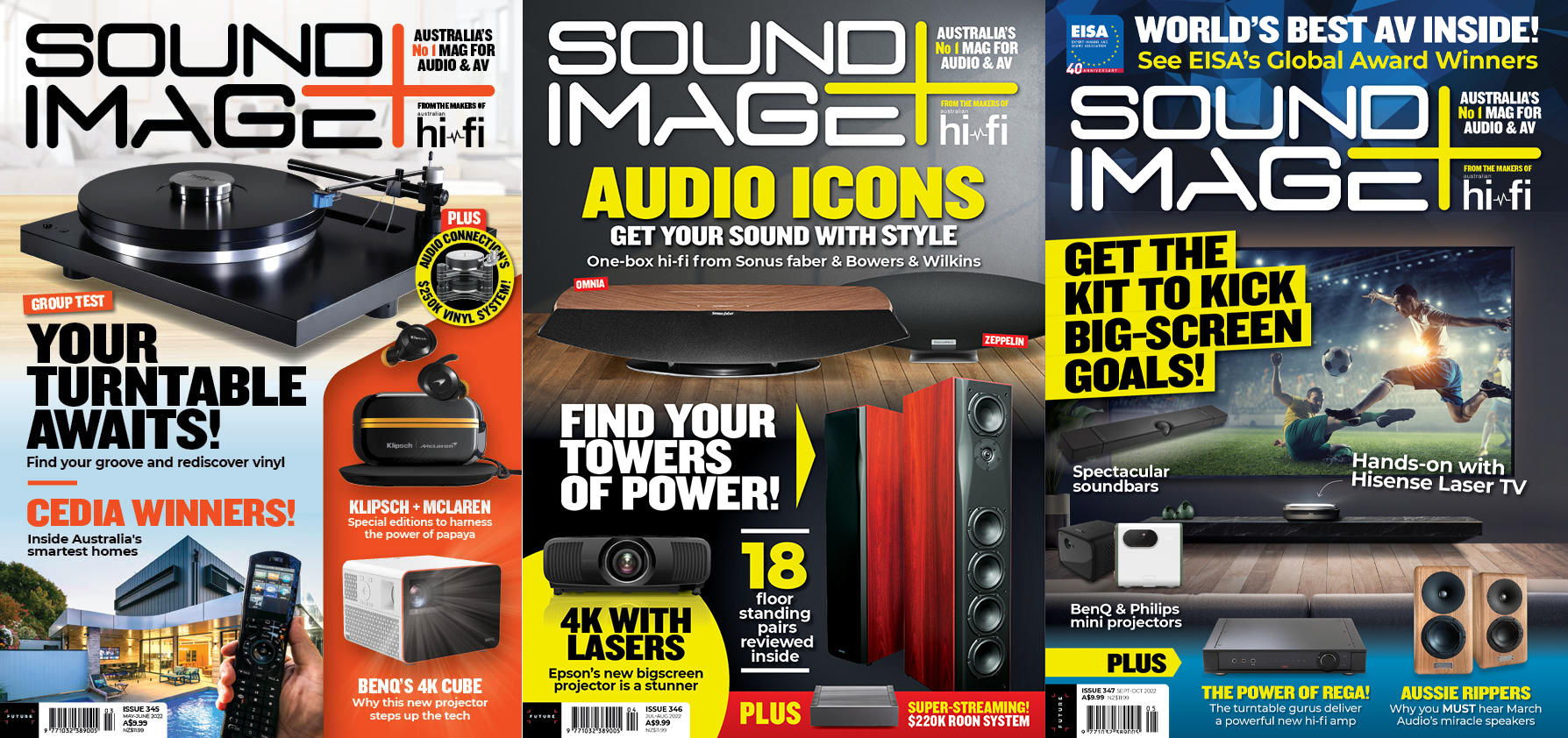
This review originally appeared in Sound+Image magazine, Australian sister publication to What Hi-Fi?. Click here for more information on Sound+Image, including digital editions and details on how you can subscribe. Read What Hi-Fi?'s global, star-rated Yamaha True X System review.
Great fanfare for Yamaha’s True X, which the company describes as a ‘True Wireless Surround system’, the surround element being small wireless surround speakers you can add to the initial package of soundbar and wireless subwoofer.
The soundbar and wireless subwoofer alone (SR-X50A) deliver 2.1.2, meaning stereo left and right from the front of the bar, plus the ‘.1’ of the wireless subwoofer, and two additional driver units on the top of the soundbar which bring Dolby Atmos height performance to this Yamaha bar.
If you then add two little speakers, called variously ‘True X Speaker 1A’ or WS-X1A, these mono speakers each connect wirelessly to the bar, extending its performance to the surround realm.
You get two 1A speakers in the $1599 True X system, so the full system delivers 4.1.2, brought together with networking and music streaming under a fairly simple app.
But there’s more – the little 1A speakers are designed to live a second life when detached from the soundbar. They can operate in ‘Solo’ mode as standalone Bluetooth speakers, paired in stereo or used separately in mono anywhere in the home and indeed beyond, thanks to an IP67 dust and water-resistance rating, and because they can play on their own battery power, as well as plugged into the mains either directly or via an optional charging cradle.
While the configuration versatility is cool, the package is of equal interest in returning Yamaha to a higher level of soundbar performance than its recent collection of effective but entry-level mini-bars. Here, indeed, Yamaha presents a complete home audio package ready to deal with movie and TV sound, music, even a kind of multiroom, as you unplug the rear speakers and take them away to play elsewhere.
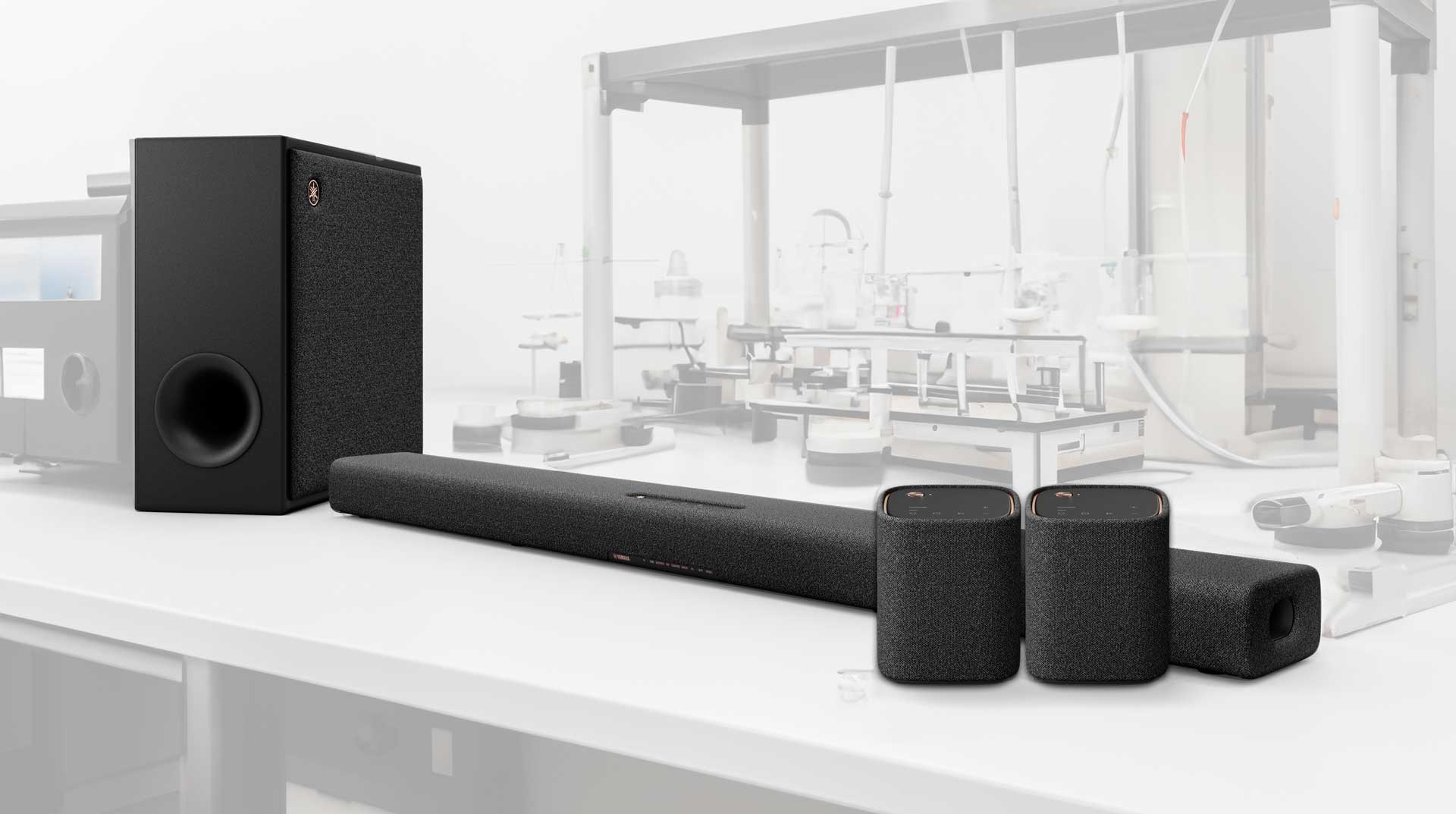
Build & facilities
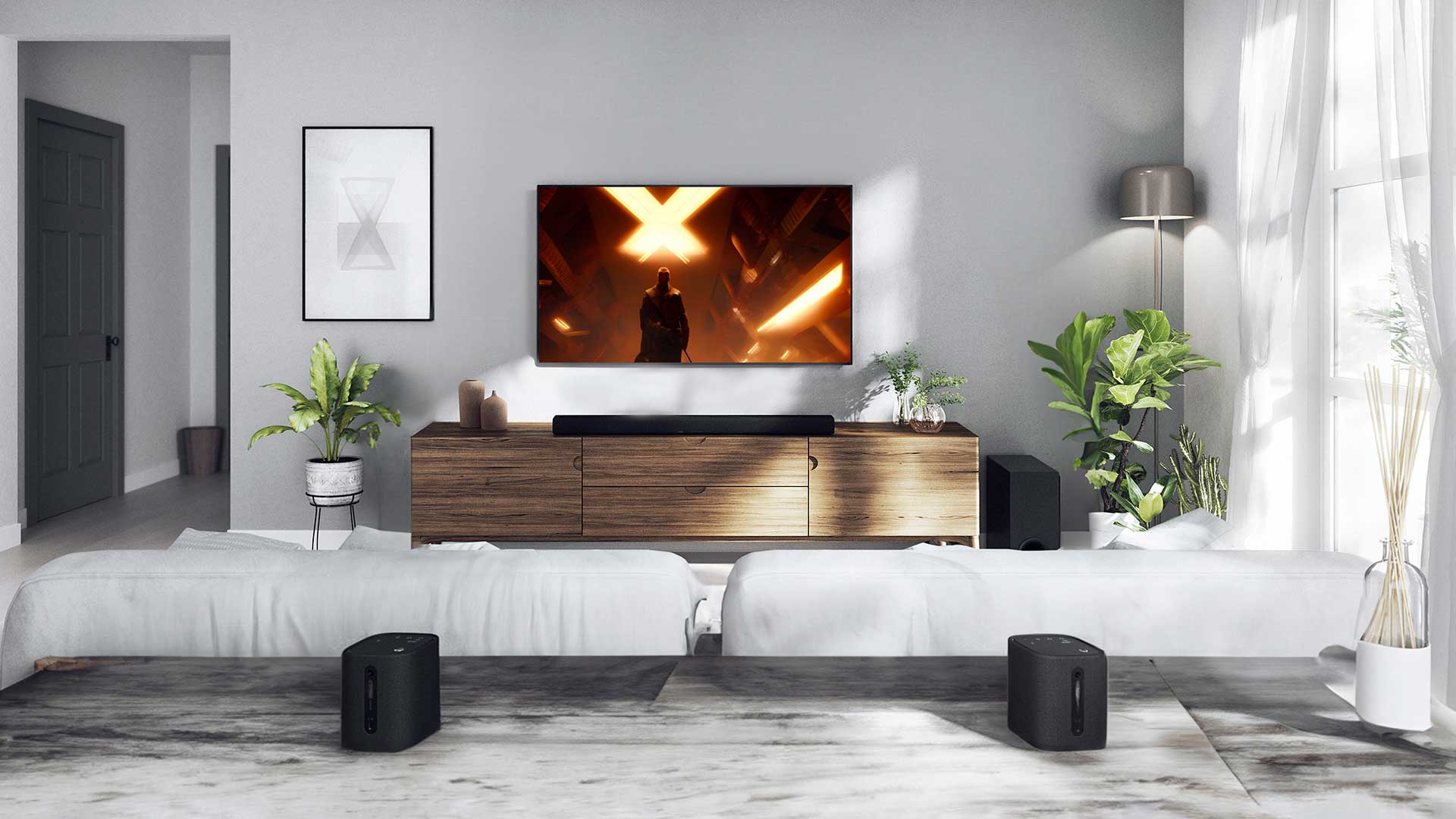
SR-X50A SOUNDBAR
Drivers: 46×66mm × 2, 75mm x 2, height 52mm × 2
Bar inputs: HDMI, HDMI ARC, optical, USB-A (update only), Ethernet/Wi-Fi, AirPlay, Bluetooth (SBC, AAC)
Bar dimensions: 1015 × 63 × 112mm
Bar weight: 3.9kg
WIRELESS SUBWOOFER
Subwoofer driver: 160mm cone
Subwoofer dimensions: 187 × 407 × 409mm
Subwoofer weight: 9.4kg
WS-X1A WIRELESS SPEAKERS (two included)
Drivers: 55mm x 1, passive radiator x 2
Dust/water rating: IP67
Power: battery, USB Type C, charging cradle
Dimensions: 88 × 105 × 88mm
Weight: 0.5kg
The 101cm-long SR-X50A soundbar gets its nice curved edges from a fabric wrap (black or carbon grey) which covers front and top, even out to the ends, down into their side ports. Under the top surface hides a pair of upward-firing drivers ready to deliver the height component of Dolby Atmos soundtracks, together with forward-firing stereo channels each with a full-range racetrack-shaped 46×66mm driver supported by a three-inch woofer.
The latest hi-fi, home cinema and tech news, reviews, buying advice and deals, direct to your inbox.
All that is further supported by the wireless subwoofer’s 160mm (6.25-inch) driver, which Yamaha says will deliver down to 35Hz, for the truly deep movie-style stuff.
Inputs are straightforward: just power, Ethernet (or Wi-Fi) to network the bar, a USB-A socket for updates only (these come over the internet anyway), and then two HDMI sockets. One of these connects to the ARC/eARC-equipped HDMI input on your TV, to play audio from the TV back to the bar, and to forward video from the second straightforward input, which we’d recommend for whatever source delivers best Atmos, be it a Blu-ray player or media player (we used an AppleTV 4K). You should get Atmos through from connected devices via your TV’s eARC, but nothing’s guaranteed with ARC, so that a direct connection will be more reliable.
Finally there’s an optical in, in case your TV doesn’t support ARC at all, or decides to prove incompatible.
This True X system is not part of Yamaha’s MusicCast series, although the bar does network, and you can use Yamaha’s ‘Sound Bar Controller’ app to access various settings. All of these are covered by the half-size slightly-fat remote, but the app gives better feedback on what you’ve selected, compared with just lights on the bar which you’ll have to learn. There are various sound modes and a ‘Clear Voice’ function to tweak the performance for different content types and usage scenarios.
The bar can also be used for music, with the app offering streaming services including Spotify Connect, Tidal Connect and Amazon Music; Apple users can stream any music to the system via AirPlay 2. Bluetooth (SBC and AAC codecs only) is also onboard.
A built-in microphone in the soundbar also enables direct voice control with the Amazon Alexa voice assistant app.
There’s a significant saving in the package. Comparing Australian prices, you could buy the bar and subwoofer alone for AU$1299, but the X-factor in Yamaha’s True X system really comes from those two little WS-X1A wireless speakers. These are priced at AU$229 each if bought separately, and you get two of them in the True X system at AU$1599.
Setting up
You don’t need the rears to use the soundbar and subwoofer, and we set things up that way in the first instance, while we waited for the little surrounds to arrive. First comes the plugging up, which is simple and easy thanks to several angled bays at the rear of the bar, and the fact that most people will attach only the power cable at one end and the HDMI ARC cable to the TV at the other. Note that you don’t get an HDMI cable in the box, just an optical cable connection.
We also plugged the subwoofer into the mains; the subwoofer power cable is perhaps restrictively short at only a couple of metres, though you could always substitute your own cable, along with bringing your own HDMI.
The subwoofer is certainly an attractive unit, particularly its right side (taking the side with the mains connection as the rear), which bears the badged and cloth-covered fixed grille beneath which the 6.5-inch driver will do its stuff, while the cabinet ports to the front. That makes it as tricky to accommodate as most subwoofers, needing a position with both acoustic optimisation (see our guide here) and a position where you’ll get the best from this driver arrangement. People say bass is non-directional, but it’s really only less directional, and we placed Yamaha’s tall sub mid-left of centre, so it wouldn’t pull too far wide from our listening position, while we’d benefit from an unobscured line to the driver, enjoying to the full whatever impact and agility it could muster.
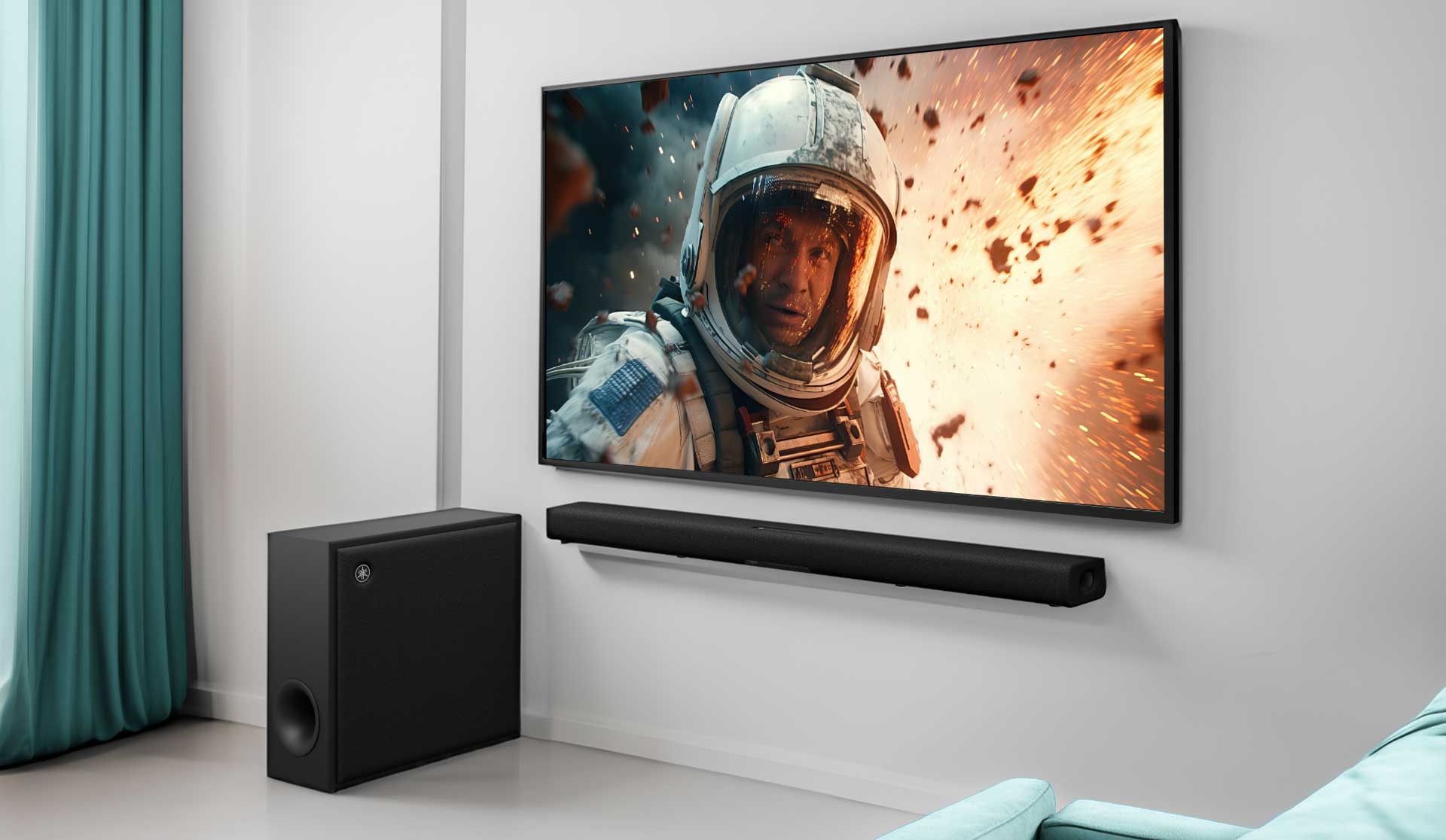
Sound performance
We ran the True X system for a week on general TV duties before connecting the rears, and throughout that time it never put a foot wrong. This is all the more remarkable given it delivers only two channels for most content, with no dedicated drivers for the dialogue-heavy centre channel.
We had wondered how this ‘phantom centre’ arrangement might impact the intelligibility of dialogue – but the answer was ‘not at all’, even when we turned off what seemed to be default ‘on’ options for Clear Voice and Bass Extension. Indeed dialogue seemed a particular strength, crystal clear even amid action scenes and slightly lifted, if anything, rather than fulfilling our fears of recession. Very often with new visiting soundbars there’s a request from the missus to reinstate our usual stereo speakers to restore clarity; that never happened here. Nor was there any ‘new remote control’ chaos, because the volume was seamlessly controlled from the Samsung TV remote (as it was similarly later with a TCL TV remote).
That leaves Yamaha’s stout remote for the dedicated user who wishes to engage further, perhaps tackling the inevitable Sound Modes.
When exactly should you select Stereo, Standard, Movie or Game? Which is purest, least processed? It seems the ‘Stereo’ mode cuts out the bar’s upward-firing drivers (and the wireless surrounds, when connected), so that’s a pure path for two-channel material. The manual says ‘Standard’ is best suited for TV programmes such as sports broadcasts, while ‘Game’ gives better localisation of sounds, it says. So it’s ‘Movie’ for everything else. That’s what we followed – though see below for the effect of a magic Atmos button.
Once settled in and accustomed to the choices, we found we could push the bar and subwoofer to impressive levels whether listening to stereo daytime TV, surround shows on streaming platforms or full-on surround movie soundtracks. The bar and sub together were consistently clean, crisp and powerful, reliably so, and never intrusive, while keeping dialogue clear: not an easy trick.
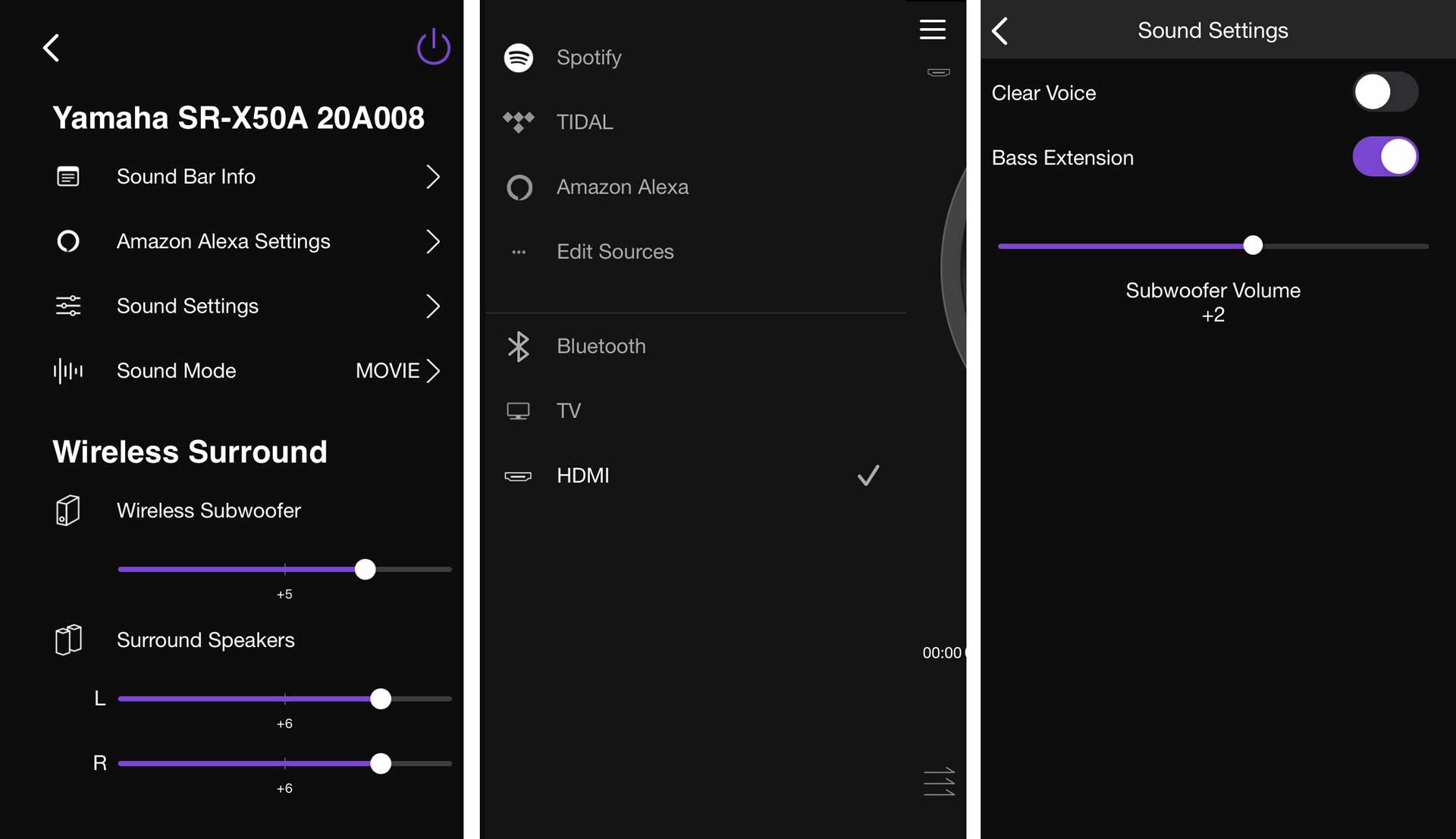
Room at the back
The ‘1A’ satellites really are surprisingly small – 11cm high with a 9cm square footprint, so elegant cuboids rather than cubes, and we just love the ‘brass’-like trimmings and buttonry.
Each unit individually is mono, equipped with a single 55mm driver and twin passive radiators, and each can take its power in any one of three ways: from its internal battery; from a cable plugged into the USB-C slot in its side; or from a neat charging base which is available separately at $39 each.
Assuming you take advantage of the little speakers’ dual usage, you’ll have a choice. Give them mains power in the same room as the soundbar, then take them away for portable use? Or power them as bedside or kitchen speakers, bringing them back for big movie nights on batteries?
The answer may depend partly on where you have power points. The speakers don’t actually come with mains plugs, only USB cables, so you need a USB outlet or adaptor – and the cables are only a metre long.
But you could, of course, maintain power cables in multiple locations, a solution which would be particularly neat if you invest in a few of the little charging docks. These score for both neatness and convenience. Without a dock, the speakers have the USB cable hanging from their side; the dock replaces that with neat cable management to the dock base, and a a three-prong connector sure to contact the golden square in the 1A’s nether regions whichever way it has been plonked down. The dock means that when you take the speaker away, you don’t have to remove the cable and hitch it up somewhere ready for its return; instead you just leave the dock behind.
We charged the 1As up and plonked them down in surround positions, out reasonably wide and slightly behind the listening position, then opened the app looking for how to pair them with the soundbar, assuming it would follow a procedure similar to Yamaha’s MusicCast Surround. But no, this is very different – and that’s perhaps a good thing, as MusicCast Surround wasn’t always entirely robust in keeping things paired and playing.
Instead here you simply turn on a surround speaker, hold down the button that switches it between ‘solo’ and ‘surround’ mode, select either ‘L’ or ‘R’ on the back, then hold down the first button again. Do that with both speakers, hold the ‘setup’ button on the bar’s remote – everything shares a plinkyplink moment, and you’re done. Crucially, since this will be a regular repeated process, this process worked every time.
‘Info’ on the remote brings basic feedback on what file type is getting through to the bar. The row of lights on the soundbar’s front lights up, and if the left light is red and the next one blank, it’s Atmos. We adjusted our TV’s settings to get Atmos flowing from its own smart apps, but we also took advantage of the bar’s additional HDMI input and plugged our 4K Blu-ray player in there directly: immediate uncompressed Atmos. Direct connection is still the best way.
There’s also an extra sound option for Atmos. If you hold down the ‘Movie’ sound mode button for three seconds, three flashes from the bar confirm you are now in ‘Setting 2: Sound characteristics for the Dolby Atmos decoder’. This went suddenly way louder and superficially sounded more spacious. But the dialogue was less intelligible, critically so. We went back by preference to ‘Setting 1: Ideal sound characteristics designed by Yamaha’. Their confidence seems justified.
In Loki S2 on Disney+ the Atmos soundtrack is almost as convoluted as the plot, and the addition of the Yamaha surrounds expanded the bar’s soundfield not only for the whizzbang action moments, of which there are a great many, but also for simple acoustic situations like the reverb of the TVA chamber in which Loki and Mobius have their first long chat in S2E1. There is no substitute for real physical rear speakers, and those upgrading from a bar with mere virtual pretence at surround will find the true immersion here bewitching on delicate material, thrilling for busier action soundtracks.
If you’re a tweaker, you’ll love the Yamaha remote control, which has buttons for everything, including separate volume pairs for subwoofer level, for each rear channel, and for overall master volume. Finding the best balance for the rears was sometimes hard: with limited bass content from the surrounds, the higher audio cues that emerged could be too distracting when high in level, not immersive enough if too low. We found best results from having the satellites at a fair distance, definitely behind us, and with corner support to diffuse and soften their sound – sacrificing some positional accuracy for immersion and fullness.
With things thus equalised the subwoofer could support the whole sound for a very effective Atmos soundfield – not the match of full-sized speakers, nor quite as immersive as some systems where the wireless rears also have Atmos upfiring speakers. But the satellites provided an excellent expansion of the bar’s already clear and dynamic delivery, and all capable of running at a significant level.
We tried Atmos music too – marvellous fun via Apple Music through an AppleTV 4K: Frankie’s Relax heaving from all speakers, Rush’s Tom Sawyer pushing the subwoofer while throwing fizzy synths around the speakers. Here there were limits on turning it up too far before things got a little raucous, even after adjusting sound settings. Certainly we don’t recommend the ‘All’ setting, which upscales anything through everything – that was most raucous and least musical of all.
We settled on Movie mode, Bass Extension on and two notches of extra subwoofer – though results will vary with rooms and positioning! That gave us a balance across both music and movies, and the purest delivery of Morten Lindberg’s Atmos test files (which usefully stream on Apple Music and Tidal Hi-Fi as well as coming on downloads and disc).
This balance made for a thrillingly spacious delivery of Georgia Gets By’s Oh Lana in Atmos, a wide open space with effects thrown to the rears and a true in-your-head chorus vocal, which speaks to tone matching between the bar and the rears here. Olivia Rodrigo’s lacy was another widespread Atmos delight, the little rears sharing the wide BVs crisply over another big open soundscape.

Going solo...
We took one of the little speakers away, switched it to ‘Solo’ and fed it Bluetooth from an iPad Pro. You are more aware of their size once they are alone, and there’s no cheating physics – there’s nothing here below 70Hz – but just enough support for a wide range of pleasant listening. Once we got one in a supportive corner, it made a nice job of Gary Moore’s Midnight Blues, the bassline surprisingly supported even when it dropped a full octave; the whole was just slightly spitty, but overall there was a remarkable spaciousness from what is, after all, a mono speaker. Mono is much underestimated, of course. Some songs should only be played this way.
Once off in their own Bluetooth world, the 1As disappear from the Sound Bar app; they become entirely local. Pricing presumably precluded True X linking everything up with MusicCast, Yamaha’s streaming and multiroom platform. But Yamaha has trademarked ‘True X’ to also cover AV receivers and amplifiers, plus their software and remote controls, so will the two worlds at some point interact? It seems a shame you could have a mix of Yamaha units at home, some of which can talk to each other, while others can’t.

Verdict
Yamaha’s True X package does an excellent job, led by the clarity of the soundbar, supported by the attractive subwoofer, and expanded with the versatile little wireless rears.
It is not without high-quality competitors from the likes of JBL and Samsung, but Yamaha both holds its own against the best of these, and undercuts them in price. The system’s ease of use and set-up, together with reliably strong and easily adjusted performance, puts it straight into our top list of soundbar recommendations.

Jez is the Editor of Sound+Image magazine, having inhabited that role since 2006, more or less a lustrum after departing his UK homeland to adopt an additional nationality under the more favourable climes and skies of Australia. Prior to his desertion he was Editor of the UK's Stuff magazine, and before that Editor of What Hi-Fi? magazine, and before that of the erstwhile Audiophile magazine and of Electronics Today International. He makes music as well as enjoying it, is alarmingly wedded to the notion that Led Zeppelin remains the highest point of rock'n'roll yet attained, though remains willing to assess modern pretenders. He lives in a modest shack on Sydney's Northern Beaches with his Canadian wife Deanna, a rescue greyhound called Jewels, and an assortment of changing wildlife under care. If you're seeking his articles by clicking this profile, you'll see far more of them by switching to the Australian version of WHF.
